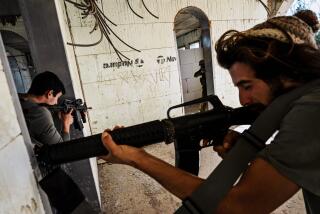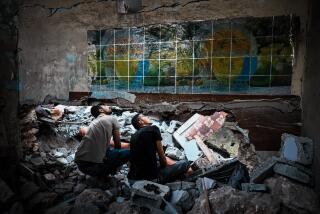Fed-Up Residents of Najaf Turn Against Rebel Cleric
- Share via
NAJAF, Iraq — Haydar Hasan Abdullah wandered the twisting streets of this ancient city on Monday looking for a fight.
He was not seeking to battle American troops who have encircled one of Islam’s holiest shrines for nearly three weeks. Instead, he wanted a shot at militants loyal to cleric Muqtada Sadr who are hiding beneath its gleaming gold dome.
“There are some fighters among the group of Muqtada who are actually saboteurs who have done such bad things to the city of Najaf,” said Abdullah, who was searching for the police station on Monday to offer himself as a recruit. “We feel so sorry for what is happening to kids, women and innocent other people. We are quite prepared to do whatever the government wants us to do.”
Sadr built his support among the poorest Shiites, Iraq’s majority religious sect that was oppressed by the Sunni-dominated government of Saddam Hussein. In fiery speeches, the youthful preacher has promised an end to the U.S.-led occupation.
Sadr’s message has resonated with his supporters in some parts of Iraq, including Baghdad’s sprawling Sadr City slum.
But in Najaf, there is growing frustration with his lengthy standoff at the Imam Ali shrine, revered among Shiites around the world as the burial place of their sect’s founder, Ali, the son-in-law of the prophet Muhammad.
The shrine, its massive cemetery and the neighborhood around it have become a bloody battleground during the last few weeks, sacrilege to many faithful.
Since Aug. 5, U.S. Marines have fought Sadr’s Al Mahdi militia in mausoleums and in private homes, on public streets and near the mosque itself. The stench of rotting corpses fills the narrow alleys.
The fighting has been fierce, close and constant.
The battles have killed at least 40 Iraqi policemen, eight U.S. soldiers and dozens of civilian bystanders. The U.S. military says it has killed hundreds of Sadr’s fighters, though the militia says its casualties have been far lower.
On Monday, two civilians -- including a baby -- were killed and two others injured. More casualties were reported in the Old City but victims could not be reached by emergency workers, hospital officials said.
Families have been trapped in their homes. Food and fuel are scarce. And many residents of Najaf, long among the Iraqi Shiites least sympathetic to Sadr, have now begun to rebel against the cleric.
Majid Saleh, a doctor who lives in a nearby neighborhood, said his house had been hit by mortar shells fired by Al Mahdi militiamen. While he escaped unharmed, a neighbor’s wife and children were killed, he said.
“I blame the men of the Mahdi army because they are kids playing with mortar shells and randomly bombing houses,” Saleh said. “I blame the U.S. government that was able to occupy Iraq in a matter of three days and hasn’t been able to enter the shrine for the past several weeks.”
The city is a center of Shiite learning and pilgrimage because of its holy sites and its role as the seat of the marjaia, the senior clerics who lead Iraqi Shiites. Many Najafis are followers of Grand Ayatollah Ali Sistani, the nation’s leading Shiite cleric.
The presence of such exalted religious figures has given Najaf special status in the minds of many locals. To them, Sadr is a relatively unlearned outsider from faraway Baghdad.
Sadr’s takeover of the shrine has also meant a drop in income for Najafis, who rely on business from the tens of thousands of religious pilgrims who make their way to the city each month.
While many Najafis may have welcomed Sadr’s resistance against the Americans, the siege has taken a toll on their livelihood as the flow of pilgrims has dropped to a trickle. Some residents refer to the seizure of the shrine as “the second occupation,” the first being the U.S. conquest of Iraq.
Small business owners have seen their shops destroyed. Families have fled their homes. Both Mahdi and American fighters have taken over buildings to use them in their battles.
One resident who stayed was Bassim Nawaf, a 45-year-old man who lives in the area surrounding the shrine.
“Most of the families who are living in the old neighborhood have left,” he said. “I stayed here with my wife and daughters. My family got used to the sound of the bombs and aren’t afraid of them anymore.”
Nawaf and several other residents said they had also seen signs that the militia fighters were suffering under the nightly attacks by U.S. AC-130 gunships, which light up the night sky.
They said the number of roadblocks manned by fighters had dwindled. Militia members appeared drawn and worn. And some had been seen leaving town.
“It was like a human wave, but now you could count them with your fingers,” Nawaf said. “The cemetery was full of fighters with different kinds of weapons, but their numbers have decreased.”
Others, however, said that volunteers continued coming into the city, stopping to ask directions on how to join Sadr’s forces.
“Sometimes Mahdi militiamen pass by without weapons, but their spirits are high, and they are hopeful that they will be martyrs” by being killed by occupation forces, said Abdul-Abbas Naja, a 22-year-old baker and neighborhood guard. “They have faith in their cause.”
Other residents expressed understanding, if not outright support for Sadr’s men, many of them young, poor and uneducated.
Um Mohammed, a nurse, said that she and her daughter had cared for several injured guerrillas.
“We do not like them, and do not support them,” she said, but added that she found herself sympathizing with some of the men.
Abbas Naji returned to the city after hearing that conditions had improved. Instead, the 33-year-old antiques shop owner found his home’s facade pockmarked with bullet holes, and American tanks parked 200 yards away.
For Naji, there is only one way out.
“It’s better to solve the conflict peacefully,” he said. “If it progressed into street fighting, it will last longer, and Iraq will become another Palestine.”
Special correspondent Salman reported from Najaf, and staff writer Miller from Baghdad. Staff writer Alissa J. Rubin in Baghdad contributed to this report, and Times wire services were used in compiling it.
More to Read
Sign up for Essential California
The most important California stories and recommendations in your inbox every morning.
You may occasionally receive promotional content from the Los Angeles Times.










